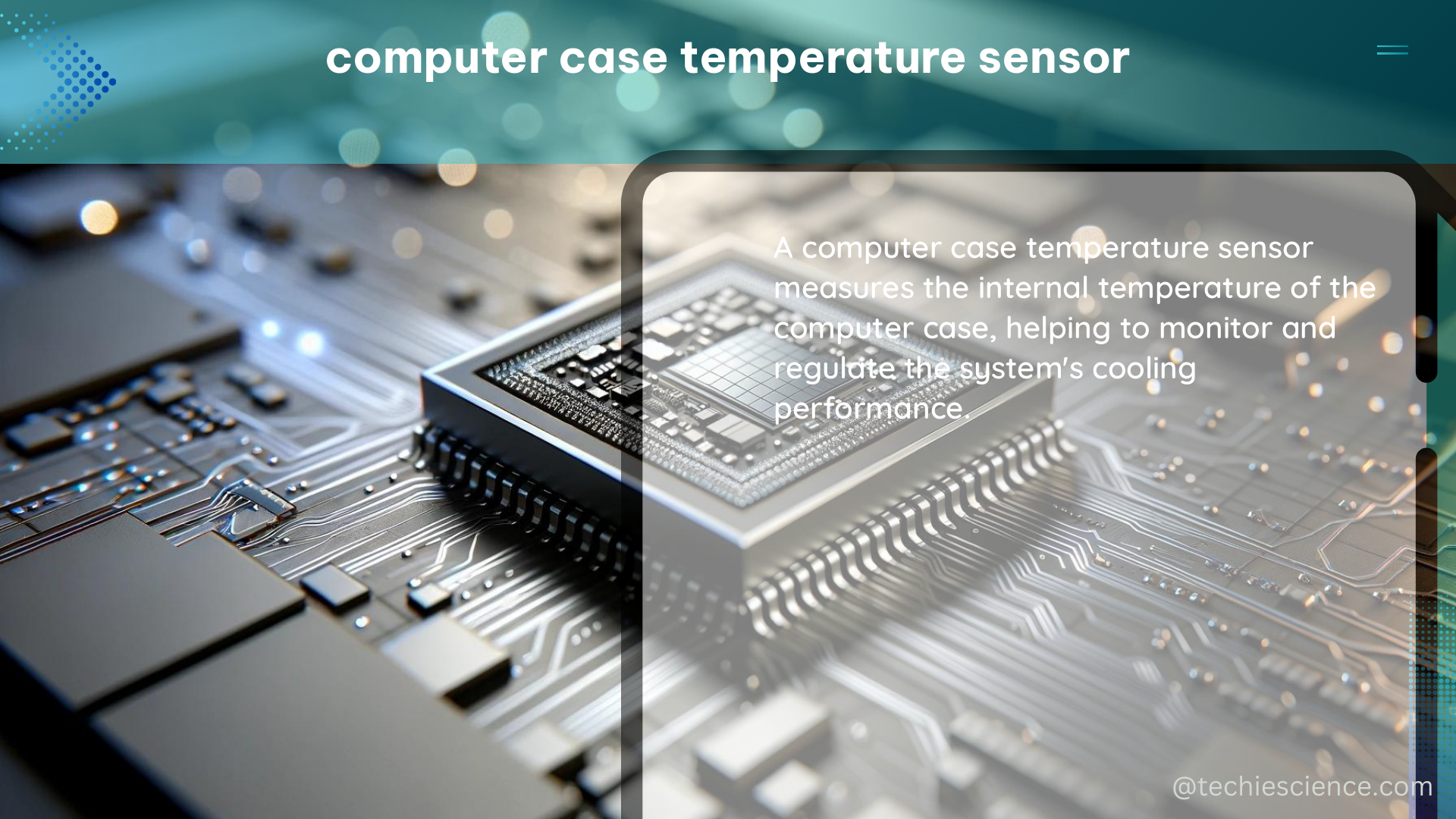Computer case temperature sensors are essential components that play a crucial role in monitoring and managing the internal temperature of modern computer systems. These sensors provide quantifiable data on the temperature inside the computer case, which is vital for maintaining the system’s performance, stability, and longevity.
Understanding Computer Case Temperature Sensors
Computer case temperature sensors typically measure the temperature in degrees Celsius (°C) or Fahrenheit (°F) within the computer enclosure. The sensor data is then utilized by the system’s thermal management software to regulate various parameters, such as fan speed and voltage, ensuring the computer operates within safe temperature limits.
Sensor Types and Specifications
-
Thermistor Sensors: Thermistors are the most common type of temperature sensors used in computer cases. They are inexpensive, compact, and offer a wide temperature range, typically from 0°C to 100°C. Thermistors can be either negative temperature coefficient (NTC) or positive temperature coefficient (PTC) types, with NTC being the more prevalent choice.
-
Resistance Temperature Detectors (RTDs): RTDs, such as platinum resistance temperature detectors (PT100 or PT1000), provide higher accuracy and stability compared to thermistors. They have a linear resistance-temperature relationship and can measure temperatures from -200°C to 850°C, making them suitable for more demanding applications.
-
Thermocouple Sensors: Thermocouples are less commonly used in computer case temperature monitoring due to their lower accuracy and sensitivity compared to thermistors and RTDs. However, they can withstand higher temperatures, ranging from -200°C to 1,800°C, and are more resistant to electromagnetic interference (EMI).
-
Semiconductor-based Sensors: Silicon-based temperature sensors, such as integrated circuit (IC) temperature sensors, offer high accuracy, fast response times, and digital output. These sensors are often used in modern computer systems for precise temperature monitoring and control.
Sensor Placement and Considerations
The placement of temperature sensors within the computer case is crucial for accurate temperature monitoring. Sensors are typically positioned near critical components, such as the CPU, graphics card, and power supply, to ensure the most relevant temperature data is captured. Additionally, factors like airflow patterns, case design, and component layout must be considered to optimize sensor placement and obtain reliable temperature readings.
Thermal Management and Monitoring

The temperature data collected by the computer case sensors is used by the system’s thermal management software to regulate various cooling mechanisms, such as case fans and heatsinks. This software continuously monitors the sensor readings and adjusts the fan speeds and other parameters to maintain the computer’s internal temperature within the manufacturer-recommended ranges.
Thermal Thresholds and Alerts
Computer systems are designed to operate within specific temperature thresholds to ensure optimal performance and prevent damage to components. Thermal management software typically includes configurable temperature thresholds that trigger alerts or initiate protective actions, such as throttling CPU/GPU performance or initiating a system shutdown, when critical temperatures are reached.
Thermal Profiling and Optimization
Advanced thermal management software can perform thermal profiling, which involves monitoring temperature data over time to identify patterns, hotspots, and potential issues within the computer case. This information can then be used to optimize the system’s cooling configuration, such as adjusting fan speeds, improving airflow, or upgrading cooling components, to enhance the overall thermal performance and efficiency.
Integration with IT/OT Convergence and IoT
The integration of information technology (IT) systems with operational technology (OT) systems, known as IT/OT convergence, has enabled the exchange of data between these domains, including temperature data from computer case sensors. IoT devices, such as sensors and actuators, play a crucial role in facilitating this integration by enabling the communication of real-world conditions, including temperature, over standard networks.
Leveraging IoT for Remote Monitoring and Control
IoT-enabled computer case temperature sensors can transmit data to cloud-based platforms or centralized monitoring systems, allowing for remote monitoring and management of the computer’s thermal performance. This integration enables IT professionals to proactively identify and address thermal-related issues, optimize cooling strategies, and ensure the long-term reliability and efficiency of the computer system.
Predictive Maintenance and Anomaly Detection
By analyzing the historical temperature data collected from computer case sensors, advanced analytics and machine learning algorithms can be employed to detect anomalies, predict potential failures, and recommend preventive maintenance actions. This predictive maintenance approach helps IT teams anticipate and address thermal-related problems before they escalate, minimizing downtime and improving the overall system’s reliability.
Specialized Temperature Sensors for Extreme Environments
In certain applications, such as high-performance computing, scientific research, or industrial environments, specialized temperature sensors may be required to withstand more extreme conditions. For example, Lake Shore Cryotronics offers germanium resistance temperature sensors that are recognized as “Secondary Standard Thermometers” and can measure temperatures from 0.05 K to 30 K with high sensitivity, excellent reproducibility, and resistance to ionizing radiation.
Conclusion
Computer case temperature sensors are essential components that provide crucial data for monitoring and managing the internal temperature of modern computer systems. By understanding the various sensor types, placement considerations, and thermal management strategies, IT professionals can optimize the performance, stability, and longevity of their computer systems. Furthermore, the integration of computer case temperature sensors with IT/OT convergence and IoT technologies enables remote monitoring, predictive maintenance, and enhanced thermal optimization, ensuring the reliable and efficient operation of computer systems in diverse environments.
References:
- IT/OT Convergence Definition
- Lake Shore Cryotronics Temperature Sensors
- Quantitative vs. Qualitative Data

The lambdageeks.com Core SME Team is a group of experienced subject matter experts from diverse scientific and technical fields including Physics, Chemistry, Technology,Electronics & Electrical Engineering, Automotive, Mechanical Engineering. Our team collaborates to create high-quality, well-researched articles on a wide range of science and technology topics for the lambdageeks.com website.
All Our Senior SME are having more than 7 Years of experience in the respective fields . They are either Working Industry Professionals or assocaited With different Universities. Refer Our Authors Page to get to know About our Core SMEs.